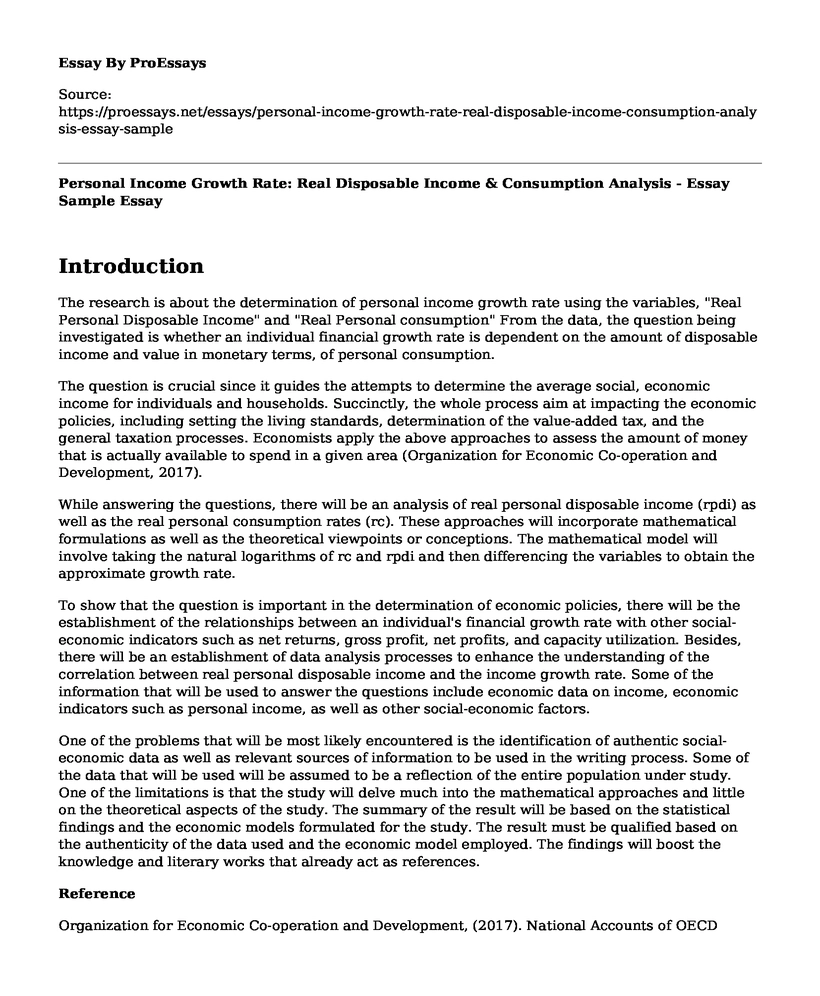Introduction
The research is about the determination of personal income growth rate using the variables, "Real Personal Disposable Income" and "Real Personal consumption" From the data, the question being investigated is whether an individual financial growth rate is dependent on the amount of disposable income and value in monetary terms, of personal consumption.
The question is crucial since it guides the attempts to determine the average social, economic income for individuals and households. Succinctly, the whole process aim at impacting the economic policies, including setting the living standards, determination of the value-added tax, and the general taxation processes. Economists apply the above approaches to assess the amount of money that is actually available to spend in a given area (Organization for Economic Co-operation and Development, 2017).
While answering the questions, there will be an analysis of real personal disposable income (rpdi) as well as the real personal consumption rates (rc). These approaches will incorporate mathematical formulations as well as the theoretical viewpoints or conceptions. The mathematical model will involve taking the natural logarithms of rc and rpdi and then differencing the variables to obtain the approximate growth rate.
To show that the question is important in the determination of economic policies, there will be the establishment of the relationships between an individual's financial growth rate with other social-economic indicators such as net returns, gross profit, net profits, and capacity utilization. Besides, there will be an establishment of data analysis processes to enhance the understanding of the correlation between real personal disposable income and the income growth rate. Some of the information that will be used to answer the questions include economic data on income, economic indicators such as personal income, as well as other social-economic factors.
One of the problems that will be most likely encountered is the identification of authentic social-economic data as well as relevant sources of information to be used in the writing process. Some of the data that will be used will be assumed to be a reflection of the entire population under study. One of the limitations is that the study will delve much into the mathematical approaches and little on the theoretical aspects of the study. The summary of the result will be based on the statistical findings and the economic models formulated for the study. The result must be qualified based on the authenticity of the data used and the economic model employed. The findings will boost the knowledge and literary works that already act as references.
Reference
Organization for Economic Co-operation and Development, (2017). National Accounts of OECD Countries: Detailed Tables. Paris: Organization for Economic Cooperation & Development.
Cite this page
Personal Income Growth Rate: Real Disposable Income & Consumption Analysis - Essay Sample. (2023, May 06). Retrieved from https://proessays.net/essays/personal-income-growth-rate-real-disposable-income-consumption-analysis-essay-sample
If you are the original author of this essay and no longer wish to have it published on the ProEssays website, please click below to request its removal:
- Some Questions on Investments
- Health Insurance and Managed Care Paper Example
- Decision Trees Essay Example
- Research Paper on Investment Process: Risk Communication & Analysis
- Research Paper on Taxation: The Unavoidable Levy of Governments
- Independent Audit Report - Free Sample
- Paper on Unit VII Capital Budgeting: NPV, IRR, Payback, and Considerations for Healthcare Trends and Inflation







